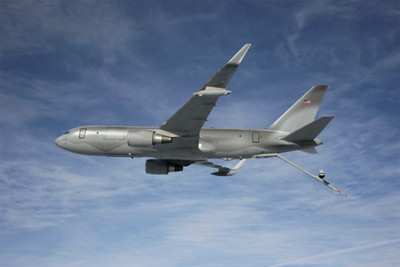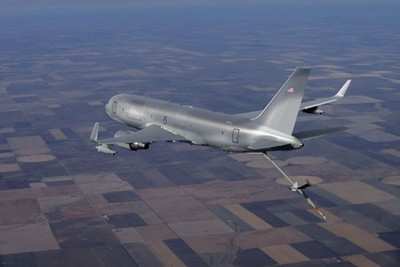Planemaker Claims Significant Fuel Savings Over Competing
Airbus Tanker
The Boeing Company's final proposal for the U.S. Air
Force’s KC-X tanker competition was submitted to the U.S. Air
Force Thursday. The proposal offers a fleet of Boeing NewGen
Tankers -- multi-mission aircraft based on the 767 platform -- that
Boeing says will deliver superior capabilities to U.S. warfighters
and burn 24 percent less fuel than the competing European
Aeronautic Defence and Space (EADS) Company’s tanker. If
selected, Boeing says its tanker will save taxpayers tens of
billions of dollars in fuel costs over the next 40 years and
support 50,000 American jobs with more than 800 suppliers in more
than 40 states.

Boeing NewGen Tanker
“This decision is critical to America’s national
security and its manufacturing base,” said Boeing Chairman,
President and CEO Jim McNerney. “Our best-of-Boeing team has
offered the most capable and fuel-efficient tanker that will enable
the U.S. Air Force to continue serving as the world’s finest
air refueling provider without breaking future defense
budgets.”
“Our challenge is to replace the KC-135, one of the most
valuable aircraft fleets in aviation history, and we responded to
the U.S. Air Force’s requirements by proposing the best
multi-mission airplane built by the most experienced people -- the
NewGen Tanker,” said Dennis Muilenburg, president and CEO of
Boeing Defense, Space & Security. “We have an integrated
team that has spent the entire competition focusing on our customer
and preparing to execute immediately after the contract is awarded.
Boeing is ready to build America’s next tanker.”
“Our NewGen Tankers will be built using a proven low-risk,
in-line manufacturing approach similar to the highly successful
737-based Navy P-8A, by an already trained and highly experienced
U.S. work force at existing Boeing facilities that have delivered
more than 2,000 tankers and 1,000 commercial 767s,” said Jim
Albaugh, president and CEO of Boeing Commercial Airplanes.

Boeing has been designing, building, modifying and supporting
tankers for decades. These include the KC-135 fleet, the KC-10
fleet, and four KC-767Js delivered to the Japan Air Self-Defense
Force. The Italian Air Force formally accepted its first KC-767
tanker in December and will receive three more as part of its
current contract. In addition to being ready now, the Boeing NewGen
Tanker will continue to deliver capability and value to both
warfighters and U.S. taxpayers for decades to come.
In a news relesase, Boeing says that the NewGen Tanker:
- Saves taxpayers up to $36 billion in life-cycle costs compared
with the competitor’s aircraft -- a difference that could pay
for an additional fleet of 179 tankers.
- Features a flight control design philosophy that places
aircrews in command of the entire flight envelope rather than
allowing computer software to limit combat maneuverability.
- Provides Air Force pilots with an advanced digital flight deck
featuring Boeing 787 Dreamliner electronic displays.
- Includes proven air refueling technology and a modernized
NewGen KC-10 boom with an expanded refueling envelope capability,
increased fuel offload rate and fly-by-wire control system -- all
from the company that invented the air refueling boom and has
produced the world’s most capable and reliable tankers.
- Delivers significantly more fuel, cargo, passengers and
patients than the current KC-135 tanker in a widebody airplane with
a narrowbody footprint that affords the Air Force invaluable
flexibility for a variety of operations.
Boeing’s final proposal is the culmination of a process
that began when the company started studying tanker requirements
after the release of the Air Force’s draft Request for
Proposal (RFP) in September 2009, followed by a final RFP in
February 2010. Boeing responded to the final RFP by submitting an
8,000-page proposal on July 9, 2010. A contractor will be selected
early this year to replace 179 of the 400 Eisenhower-era KC-135
aircraft currently in the Air Force fleet.
 Aero-FAQ: Dave Juwel's Aviation Marketing Stories -- ITBOA BNITBOB
Aero-FAQ: Dave Juwel's Aviation Marketing Stories -- ITBOA BNITBOB NTSB Prelim: Rutan Long-EZ
NTSB Prelim: Rutan Long-EZ ANN's Daily Aero-Term (12.05.25): Hazardous Weather Information
ANN's Daily Aero-Term (12.05.25): Hazardous Weather Information Aero-News: Quote of the Day (12.05.25)
Aero-News: Quote of the Day (12.05.25) Airborne-Flight Training 12.04.25: Ldg Fee Danger, Av Mental Health, PC-7 MKX
Airborne-Flight Training 12.04.25: Ldg Fee Danger, Av Mental Health, PC-7 MKX




